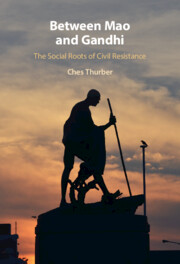Book contents
- Frontmatter
- Dedication
- Contents
- List of Figures
- List of Tables
- Acknowledgments
- 1 Pathways to Revolution
- 2 Social Ties and Civil Resistance
- 3 Nepal’s Gandhians Take Arms
- 4 Nepal’s Maoists Take to the Streets
- 5 Syria in the Arab Spring
- 6 Resisting Colonial Rule in the Syrian Mandate
- 7 Barriers to Civil Resistance: A Global Analysis
- 8 Gandhi Revisited: Overcoming Barriers to Civil Resistance in South Africa and India
- 9 Conclusion
- Appendix: Notes on Field Research in Nepal
- References
- Index
- Series page
3 - Nepal’s Gandhians Take Arms
Published online by Cambridge University Press: 17 September 2021
- Frontmatter
- Dedication
- Contents
- List of Figures
- List of Tables
- Acknowledgments
- 1 Pathways to Revolution
- 2 Social Ties and Civil Resistance
- 3 Nepal’s Gandhians Take Arms
- 4 Nepal’s Maoists Take to the Streets
- 5 Syria in the Arab Spring
- 6 Resisting Colonial Rule in the Syrian Mandate
- 7 Barriers to Civil Resistance: A Global Analysis
- 8 Gandhi Revisited: Overcoming Barriers to Civil Resistance in South Africa and India
- 9 Conclusion
- Appendix: Notes on Field Research in Nepal
- References
- Index
- Series page
Summary
This chapter traces the strategic evolution of the Nepali Congress from its deliberation and rejection of nonviolence through a vote of party leaders in Calcutta in 1950 to its gradual return to an exclusively nonviolent platform by 1990. It illustrates that the movement's lack of social ties with other groups within Nepal limited its ability to generate mass mobilization, causing leaders to sour on the prospects of being able to achieve victory through civil resistance. But over the course of the following four decades, the Nepali Congress party was able to substantially enlarge its social base in ways that made it far better positioned for civil resistance. Interestingly, a challenger with a very different ideology, the Marxist-Leninists, underwent a very similar transition. After a failed effort at inciting revolution through the beheading of “class enemies” in the early 1970s, the Marxist-Leninists, like the Nepali Congress, engaged in a program of organization- and coalition-building that paved the way for the adoption of civil resistance.
- Type
- Chapter
- Information
- Between Mao and GandhiThe Social Roots of Civil Resistance, pp. 54 - 80Publisher: Cambridge University PressPrint publication year: 2021



